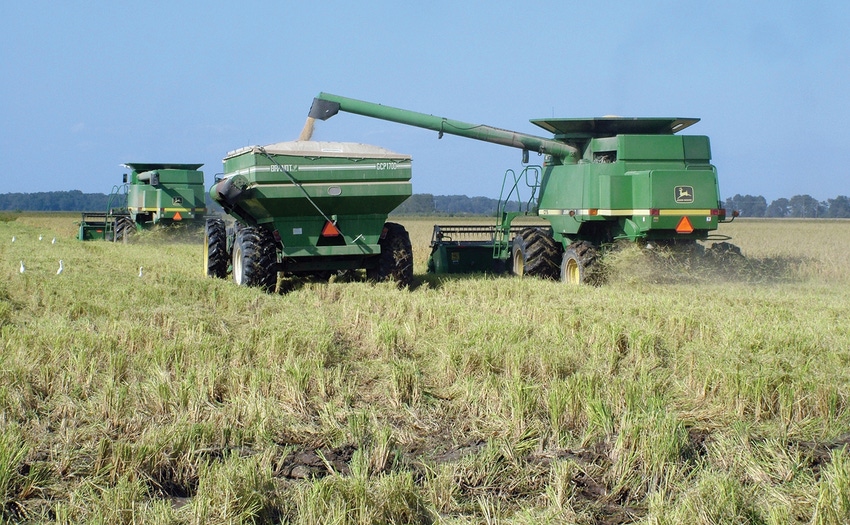October 3, 2018

U.S. exporters are expected to ship more milled and rough rice in 2018-19, according to analysts with USDA’s Economic Research Service. Exports of long-grain and medium- and short-grain rice are both forecast to rise about 13 percent.
That’s the good news. The not-so-good news is that despite the higher sales, all-rice ending stocks are expected to be up 53 percent and long-grain ending stocks 54 percent. Prices of all classes of U.S. rice are expected to decline.
“None of these numbers are anywhere near a record,” says Dr. Nathan Childs, senior agricultural rice economist with the USDA Economic Research Service, referring to the latest USDA rice supply and demand projections. “And even to achieve these growth rates, the U.S. has to be more competitive.”
Childs was the speaker for a University of Arkansas System Division of Agriculture Food and Agribusiness webinar (https://youtu.be/KzndmYUInvs.) The series is moderated by Dr. Bobby Coats, professor in the Department of Agricultural Economics and Agribusiness at the university.
It was the second Food and Agribusiness Webinar presentation by Childs in about a month. The earlier event came just before USDA’s World Agricultural Supply and Demand Estimates Board gave its September forecast.
“I believe I was here about 30 days ago,” he said. “We’ve had a new lockup, a new WASDE report and we’re going to spend the next 45 minutes talking about these changes and their implications.”
U.S. producers account for a very small portion — 1 to 1.5 percent — of the world’s rice production, Child’s noted. Nevertheless, U.S. exporters typically are responsible for 6 to 7 percent of the world’s rice trade.
Global market important
“The global market is very important for the U.S., and changes in world production resonate with U.S. producers,” he said. “World rice production for 2018-19 is projected at 487.2 million metric tons or almost 4.5 million below the 2017-18 record. But global rice supplies are projected to be record high.”
In part, that’s because China and India — the world’s largest rice producers — each had record crops in 2017-18. Both will be down somewhat in 2018-19, but a number of other countries, including the United States, are expected to harvest larger crops in the current marketing year.
India, which has continued to emphasize becoming more self-sufficient in all crops, produced 113 million metrics tons in 2017-18, while China’s farmers harvested almost 146 million metric tons. Both are expected to be down in 2018-19 due to decreases in planted area.
Normally that would be positive for world rice prices, but larger crops are forecast for at least 15 countries, some of which have not traditionally been players in the world rice markets. Besides the United States, all are in Asia or Africa.
“Production is expected to be larger for Bangladesh, Burma, Cambodia, Côte d’Ivoire, Ghana, Guyana, Indonesia, Laos, Madagascar, the Philippines, Sri Lanka, Tanzania, Thailand, the United States and a slight increase in Vietnam,” he said.
USDA made major revisions in its September World Agricultural Supply and Demand Estimates, according to Childs. The September report provides the year-end estimates for the rice marketing year, which runs from August to July for U.S. growers.
Imports lowered
All rice and long-grain imports were lowered fractionally based on year-end census trade data, he said. Medium-grain and short-grain supplies were increased slightly.
“Those numbers had little impact on overall supply,” Childs noted. “But ending stocks were not a small adjustment — this was large. Ending stocks of all rice were lowered by 5.4 million hundredweight to 29.4 million, based on the August NASS Rice Stocks report. Long-grain was lowered 3 million hundredweight; medium-grain, under 200,000; and brokens, 2.1 million.
“Total exports for 2017-18 were increased 500,000 hundredweight to 87 million after the census data came in a little higher. Long-grain increased 300,000 hundredweight; medium-grain, 100,000 hundredweight. But that wasn’t much.”
Domestic and residual use of all rice was increased 4.8 million hundredweight with long-grain raised 2.6 million hundredweight and medium-grain and short-grain rice 2.2 million hundredweight.
USDA is forecasting the 2018-19 U.S. rice crop will be 4 percent bigger at 219.5 million hundredweight “due to a larger area estimate reported by the USDA National Agricultural Statistics Service that incorporated Farm Service Agency sign-up data.”
The department reduced carry-in stocks by 5.4 million hundredweight based on NASS stocks data, he noted. Domestic and residual use of all rice was increased 2 million hundredweight to 133 million hundredweight. Ending stocks of all rice were increased 3 percent to 44.9 million hundredweight, which would be up 53 percent from 2017-18.
“That (219 million hundredweight) is a big crop,” he said. “The national average prices were lowered due to the larger supplies. There’s plenty of rice out there, a lot of rice in the global market.”
Questions remain
Questions remain about where the U.S. can increase its export shipments. “South American exporters continue to gain market share in Mexico,” he said. “The U.S. now accounts for really less than 70 percent of Mexico’s rice imports. Ten years ago, it was close to 99 percent.
“Export opportunities and concerns, lower and more competitive prices, which I showed earlier, will allow the U.S. to regain some lost market share in Mexico, Central America, and Venezuela,” he said.
Other questions include whether Asian exporters will ship milled rice into South America, Central America, and Mexico? And whether the U.S. can increase its sales from the current 30,000 tons to Iraq, compared to 94,000 tons in 2017-18?
Analysts are also asking if the U.S. can make sales of medium-grain rice to North Africa, one of the fastest-growing rice markets in the world, and the Middle East? “Will the U.S. pick up some of Egypt’s former market or could it sell rice to Egypt?” he said. “If it did, what type of class?”
About the Author(s)
You May Also Like






